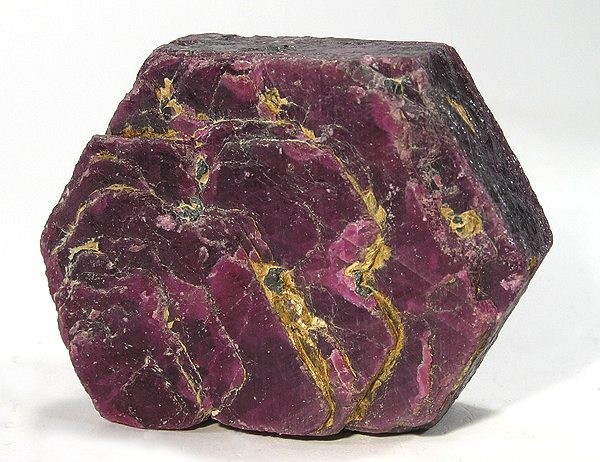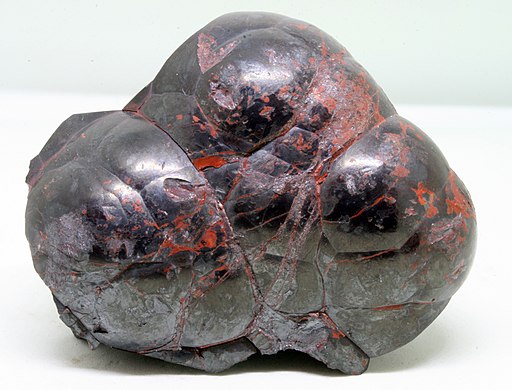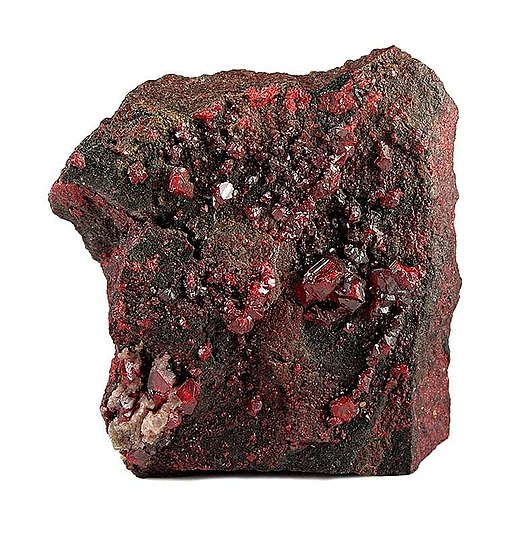9.2 Economic Minerals
Carolina Londono Michel
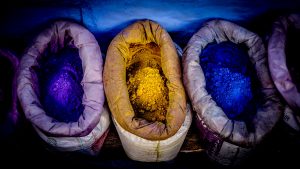
Mining is the extraction from the Earth of valuable material for societal use. Usually, this includes solid materials (e.g. gold, iron, coal, diamond, sand, and gravel), but can also include fluid resources such as oil and natural gas. Mining has a long relationship with modern society. The oldest evidence of mining, with a concentrated area of digging into the Earth for materials, has a history that may go back 40,000 years to the hematite (used as a red dye) of the Lion Cave in Swaziland [1].
Mineral resources, like other natural resources, are unevenly distributed on Earth. This is not random, geological processes mandate the distribution of mineral resources. For example, notice in Fig 9.2.2. how copper deposits (yellow triangles) appear along the western margin of the Americas. In North America, iron deposits (red triangles) are concentrated mostly in the midwest of the United States. The cause of the heterogeneous distribution relates to the different geologic histories of these areas that have accumulated these elements in those particular areas.
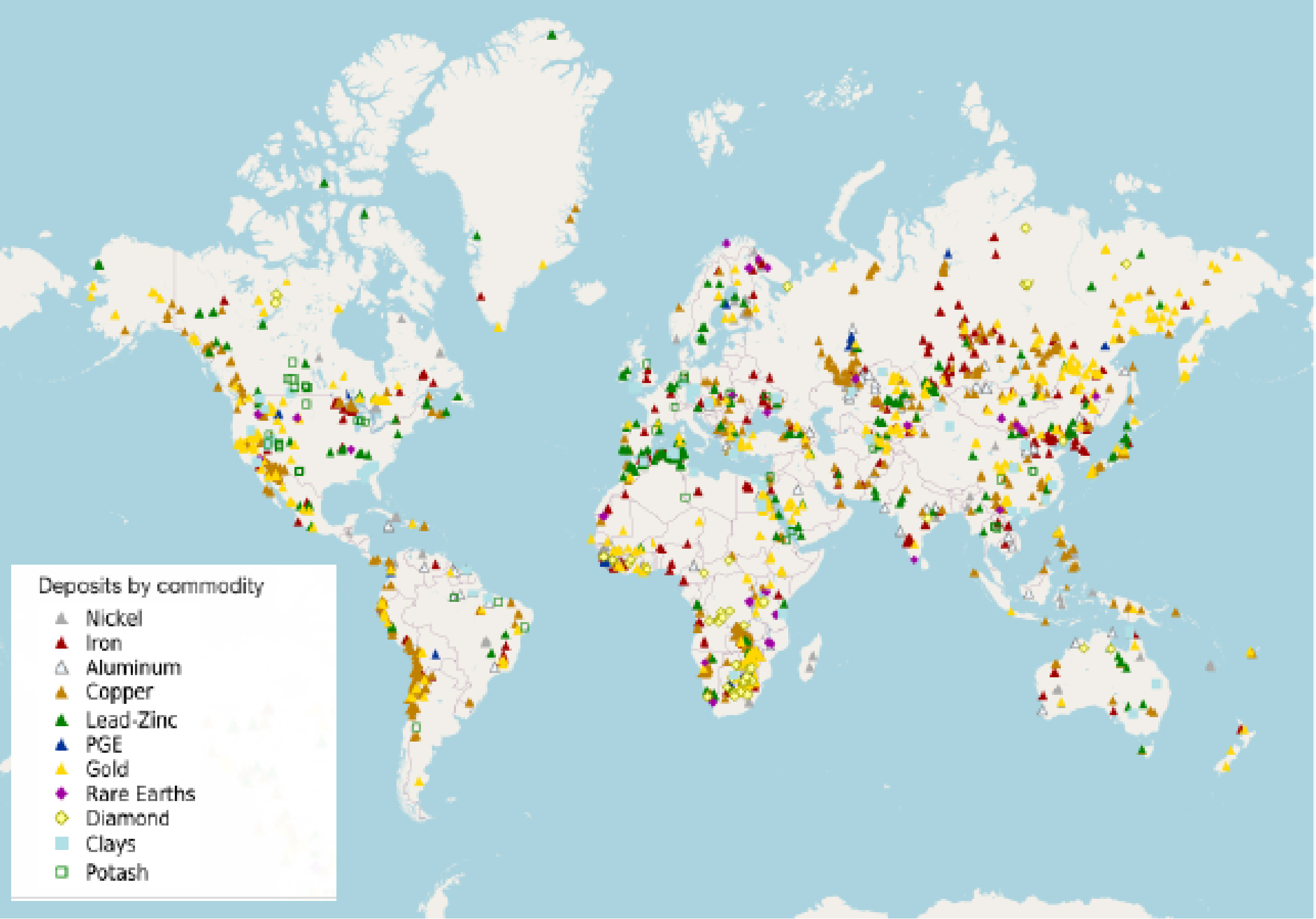
Human populations have historically concentrated at sites that are geologically helpful to commerce, food production, and other aspects of civilization. Indeed, geology has shaped human history! The uneven distribution has extremely important social, economic, and political implications. The opposite is true, policy, economics, and other factors result in uneven production; few countries control mineral production. This means that countries depend on other countries for resources. Although this seems like a problem, it is evidence of our interconnectedness and interdependence, and, ideally; it encourages governments to collaborate and maintain peace with each other. Observe in Figure 9.2.3 which countries supply the most material to the US.
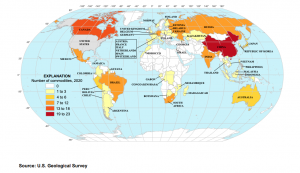
Classification of Mineral Resources
We can classify mineral resources in various ways, according to their use (industrial, agricultural, construction), their relative abundance (scarce, abundant), or their perceived value (precious vs. base metals), etc. A practical classification is to divide them into non-fuel and fuel minerals. Non-fuel minerals can be further divided into metallic resources, natural aggregates, and other industrial minerals, as shown in Table 9.2.1. We will study the general mining aspects of non-fuel minerals. Fuel minerals will be addressed in subsequent chapters.
| Ch. 9. Nonfuel Minerals | Metal or Metallic | aluminum, iron, copper, lead, zinc, tin, gold, silver, etc. |
| Natural Aggregates | cement, sand, gravel, and crushed stone | |
| Other Industrial Minerals | Borates, salt, lime, phosphate rock, soda ash, clay minerals, gypsum, industrial sand, iron oxide pigments, Iodine, Magnesium compounds, mica, peat, perlite, pumice, talk. | |
| Ch. 10. Energy Fuel Minerals | Hydrocarbons | Petroleum, natural gas, coal, unconventional hydrocarbons |
| Non Hydrocarbons | Uranium |
Metal Mining
The periodic table contains the known elements that make up the Earth. However, it is rare for the amount of the element to be concentrated to the point where the extraction and processing of the material become profitable. Mineral deposits in which the material can be mined at a profit are called ore deposits. Geologists evaluate the size of the deposit, the concentration of the ore mineral(s), and the production and transportation costs to determine if a deposit is economical. Typically, the term ore is used for only metal-bearing minerals, though the concept of ore as a non-renewable resource can be applied to valuable concentrations of fossil fuels, building stones, and other non-metal deposits, even groundwater. However, the term “natural resource” is more common than ore for these types of materials [1]. It is implicit that the technology to mine is available, economic conditions are suitable, and political, social, and environmental considerations are satisfied in order to classify a natural resource deposit as ore.

Ores can be concentrated in a set of narrow veins or they can be distributed over a large area in low concentrations. Some materials are mined directly from bodies of water (e.g. sylvite for potassium; water through desalination) and the atmosphere (e.g. nitrogen for fertilizers). These differences lead to various methods of mining, and differences in terminology. Miners use the term ore mineral resource for ore that is potentially extractable (in theory), and the term ore mineral reserve for a well-defined (proven), profitable amount of extractable ore with the current technology and methods [1]. In other words, a reserve is when you know how much of an ore resource you can actually extract using the current technology.
What are some common ore minerals?
Ore minerals contain elements and compounds concentrated by factors of hundreds, thousands, or tens of thousands as compared to their average concentrations within the Earth’s crust. It is this concentration that makes them economically desirable. For example, the average crustal abundance for gold is 0.0000002%. A gold accumulation should have 4,000-5,000 times the crustal concentration to be profitable. Figure 9.2.4 shows an ore for copper, Bornite. We use copper for electrical wires, plumbing, and electronics, but we need to extract it and further concentrate it from minerals such as bornite, azurite, chalcocite, chalcopyrite, etc. Table 9.2.2 presents other ore minerals. Refer to Chapter 3 if you need a refresher on mineral properties.
The part of an ore, usually. metallic, which is economically desirable, as contrasted with the gangue.

